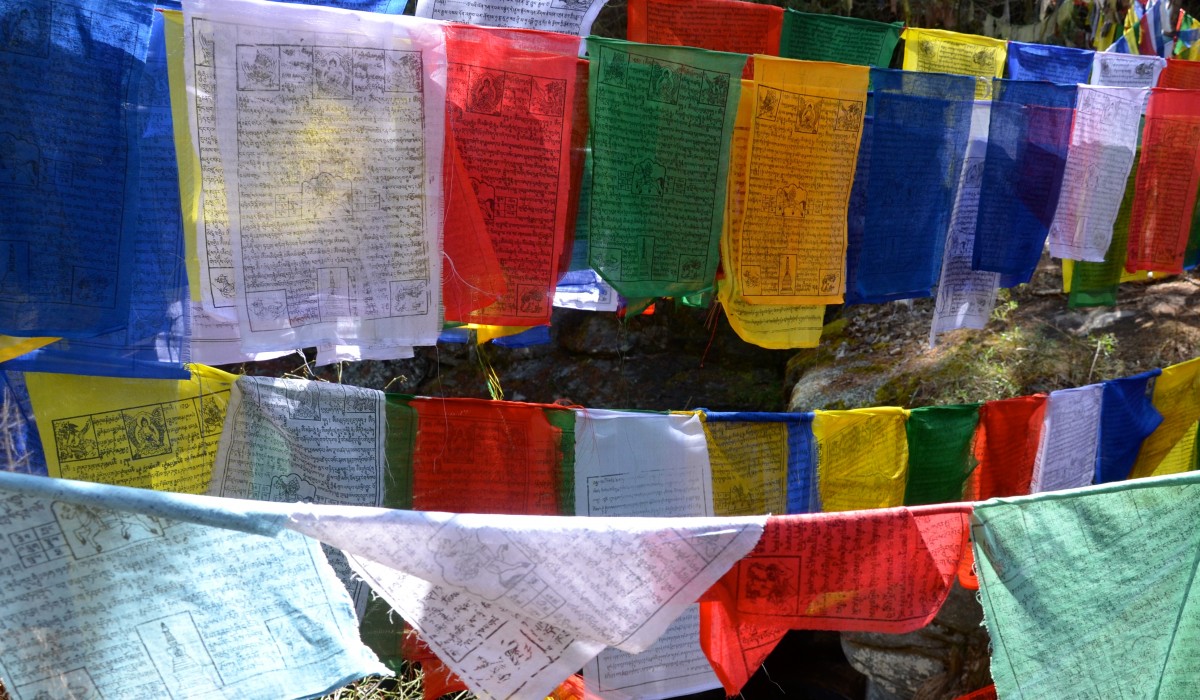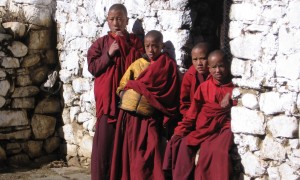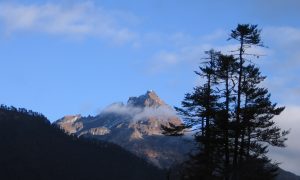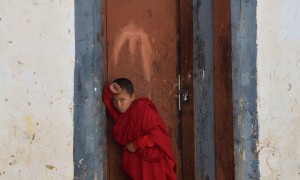 I’ve had a lot of people ask me to tell them about my recent trip to Bhutan.
I’ve had a lot of people ask me to tell them about my recent trip to Bhutan.
It’s very tempting to respond with “It was interesting” or “I had a great time.” Instead, I like to answer the question with something specific about the country that will stick in their minds.
What sticks in my mind about Bhutan is the ever presence of religion. In a country that is 95 percent Buddhist it is very hard to separate Buddhism from the country. We had lots of visual reminders.
We saw lots of the golden roofs indicating a temple, on hilltops sometimes in the clouds, nestled into contemplative places and in the dzongs—the large fortress like buildings which housed the government and the monasteries through out the country.
Look for the golden roof tops of temples.
Even the icon for the country, the Tiger’s Nest , is a monastery. (Note: I didn’t get this close. Had to use an image from the Internet).
In Bhutan, temples are venues of quiet and peace, located away from the hustle bustle of daily life offering opportunities for meditation.
Every day we visited a couple of temples. Even high on the top of a mountain pass, our lunch break one day included a temple visit. Peaceful and contemplative and so different from the fast food and touristy spots we might see in our country.
Before this trip I didn’t really understand the role of the ever present prayer flags.
What I learned is that the long strings of colorful flags with printed messages on them are prayers for the general health and well being of all sentient beings. When you string them up where the wind blows (almost everywhere in Bhutan) the messages are flung into the universe and hopefully will come back to you.
The joyful colors represent earth, fire, sky, water and air.
We stopped one day to string some up high on a remote mountain pass. I love the idea that my heartfelt wishes for the well being of all are being spread to the vast universe.
Sending our prayers for the good of all sentient beings to the universe.
The long white flags are erected when someone dies. The loved one is cremated and the white flags will send his or her soul to the universe. We saw them everywhere, a constant reminder of the impermanence of life in a beautiful dreamy way.
Tsa Tsa Memorials
The family of a deceased person could elect to place Tsa Tsa Memorials in beautiful places. We saw them by roadways, nestled into rocky spots and in settings with serene and lovely views.
Tsa Tsa Memorials are created by monks and nuns from the ashes of of the cremation pyres and molded in special ceremonies. They are commissioned by Buddhist families to honor and say goodbye to loved ones and then placed in sacred venues or places special to the loved one.
Chortens are constant reminders of the role of Buddhism in Bhutan
We also saw Chortens (called Stupas in other countries) quite frequently throughout each day.
Chortens are religious structures often located at the bends of rivers because they were designed to chase away the evil spirits lurking in rivers. They provide a constant reminder of the importance of religion. Sometimes they house important religious relics. We enjoyed learning the difference in style among the Nepalese, Bhutanese and Tibetan Chortens.
Prayer Wheels in Bhutan
Mostly I loved the prayer wheels. The first one I saw in Paro stopped me in my tracks. It was right next to the main square of town. I saw a lady walk over to it and then walk around the wheel three times. I heard the bell ring each time. And it looked to me that she was chanting.
Turns out she was chanting a mantra for the good of all sentient beings. Again, her prayers are believed to go out into the universe. I loved that in the middle of her day of errands, picking kids up from school or visiting a grandmother, she stopped to chant her prayers.
The actual words are OM MANAI PADMAY HUNG. The translation is “May all sentient beings be free from suffering.”
Pretty soon I noticed them everywhere. Hotels. Street corners. By temples. Sometimes there were rows of small ones. And sometimes I saw people with small hand held prayer wheels.
I loved the early mornings when I’d head out of the hotel before breakfast for a walk and see the drivers of the small buses in the parking lots cleaning the buses. Soon one would break away to walk around the prayer wheel to chant his prayers.
No need to go to a temple to pray. Take a quiet and contemplative break any time, anywhere, when you are in Bhutan.
Be sure to come back and enjoy more of Bhutan with me on DesignDestinations.org and tell me what you think. I’m bursting with experiences to share.
My first two blogs have been Bhutan: Splendid Isolation and Faces of Bhutan. Enjoy! I traveled with GeoEx.
 I hope you have enjoyed the drawings in this blog post created by Colin Christy. Colin is on the staff of GeoEx in California and joined us on our journey.
I hope you have enjoyed the drawings in this blog post created by Colin Christy. Colin is on the staff of GeoEx in California and joined us on our journey.
































Comments
7 CommentsJulie Hawksworth
May 18, 2015Hi Susan – a very interesting post and what stunning photos! Particularly interesting that such a high percentage of people are Buddhist, must be a peaceful place!! I used to think that the US was the most religious country, so I had a similar surprise when I visited parts of Asia and saw how devout the worshippers (Muslim, Buddhist, Christian) were, with public praying occurring every day and long religious festivals. Will go back and read your other posts soon!!
Susan J. Smith
May 19, 2015Thank you so much for you interesting comment.
Cindy
May 19, 2015What an incredible journey and experience!
Susan J. Smith
May 19, 2015It was. Wonderful experience. I have done three blog posts and have there more in the works. Hope you continue to enjoy.
Michelle Slikkers
May 19, 2015Susan, I am so overwhelmed by this piece. You are so talented at protraying this incredible culture through your words and photographs! Thank you for such a wonderfully thoughtful piece!
JoAnne Tompkins
May 25, 2015Susan, I love that you were up early in the morning and witnessed the bus drivers breaking away from cleaning their buses to walk around the prayer wheels chanting. How lovely that their call to prayer is so thoroughly woven into their daily lives.
Susan J. Smith
May 26, 2015Thank you JoAnne,
I think your way of describing that “prayer is woven into their daily lives” really says what we experienced in Bhutan. It really is what makes Bhutan, Bhutan. That and the isolation.
Susan